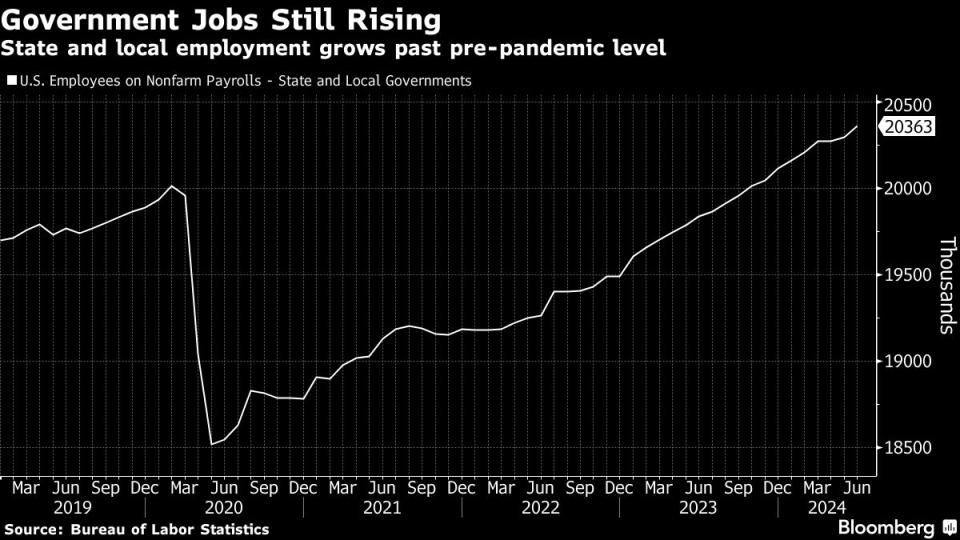US States, Cities’ Hiring Heats Up as Private-Sector Growth Cools

(Bloomberg) -- US states and cities added about 65,000 jobs last month, pushing their combined payrolls far above pre-pandemic levels in a trend that contrasts with a slowing private-sector market.
Most Read from Bloomberg
Saudis Warned G-7 Over Russia Seizures With Debt Sale Threat
Microsoft Orders China Staff to Use iPhones for Work and Drop Android
S&P 500 Holds Gains as Fed Bets Steady on Powell: Markets Wrap
Biden’s Biggest Donors Left Powerless to Sway Him to End Bid
Buoyed in part by remaining federal pandemic aid, the hiring drove almost a third of total US non-farm payroll growth in June, according to federal data released Friday. The municipalities have increased personnel in every month but one since early 2022.
States and localities now employ almost 20.4 million people, more than 300,000 above the level on the eve of the pandemic. The outbreak triggered an abrupt shutdown of schools and other government activities and led local officials to slash more than a million jobs. It also fueled a massive labor shortage that left localities struggling to attract workers.
“Early on, after the pandemic, the public sector could not compete with private-sector wages,” said Dante DeAntonio, a senior director and economist at Moody’s Analytics. “Now that private-sector hiring has started to slow, the governments are able to step up and fill that hole.”
US hiring slowed last month and the unemployment rate rose to the highest since 2021, bolstering bets that the Federal Reserve will lower borrowing costs this year. Overall, US employers added 206,000 nonfarm jobs and prior months saw steep downward revisions.
For localities, surpassing pre-pandemic job levels is a good sign, but probably not enough given the governments’ expanding needs and population growth, said Elise Gould, senior economist at the Economic Policy Institute, which studies policies for low- and middle-income workers.
“It’s a good benchmark, but it’s probably still not nearly enough,” she said.
As Justin Marlowe, director of the Center for Municipal Finance at the University of Chicago, sees it, the pace of local hiring is a reflection of strong revenue forecasts and budgeting decisions from last year.
“It takes many months to post and fill government positions,” he said. “Meanwhile, today many state and local revenue forecasts are far less optimistic than this time last year.”
And with cities boosting pay levels to attract and retain employees, there will likely be a future budgetary impact, he said.
There’s also the eventual sunset of pandemic-era federal aid, which means the June pace of job gains may be unsustainable. States and local governments received $350 billion from the American Rescue Plan to help mitigate the economic fallout from the pandemic.
“That flow of funds is starting to slow and will eventually stop,” said DeAntonio at Moody’s. “The next 12 months are almost certainly going to be slower than the last 12 months.”
--With assistance from Amanda Albright.
(Adds information on pandemic aid in penultimate paragraph. A previous version corrected the name of the firm in the fourth paragraph.)
Most Read from Bloomberg Businessweek
At SpaceX, Elon Musk’s Own Brand of Cancel Culture Is Thriving
How Stocks Became the Game That Record Numbers of Americans Are Playing
©2024 Bloomberg L.P.

 Yahoo Finance
Yahoo Finance 